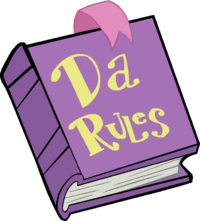Tossup
Tossup-Bonus Format
(Tossups · Bonuses)
Studying · Writing · Editing
NAQT · ACF · Housewrites
The circuit · Outreach
Resources
hsquizbowl.org
(database · archive · forums)
Discussion forums
College directory
Before the game
During the game
A tossup (or toss-up) is a question, usually containing several sentences, that is read out loud for both teams to attempt to answer. During a game, any player who believes they know the answer to a tossup can use their buzzer to interrupt the question and deliver an answer in an attempt to score points for their team. Tossup questions are the staple of gameplay for virtually all contemporary quizbowl.
"Good quizbowl" advocates for tossups in pyramidal style, in which a question begins with more in-depth knowledge about the answer and progresses towards easier clues, the intent being that more knowledgeable teams should answer before less knowledgeable teams.
In Britain, tossups may be called "starters."
Rules
Correctly-answered tossups are usually worth 10 points, though some tournaments allow for powers, in which an increased number of points, usually 15, is rewarded for a correct answer being given early in a tossup. When a player negs, or gives an incorrect answer before the tossup's end, their team cannot attempt to answer the question again and, under some rules, loses points.
Players have a finite amount of time after buzzing to provide an answer. In ACF, PACE, and NHBB gameplay rules, players have five seconds to begin their answer, while under NAQT rules, players have only two seconds. Additionally, if nobody buzzes in within five seconds (under ACF and PACE rules) or three seconds (under NAQT rules) of the end of a tossup, it is considered "dead," and the next tossup is read instead of proceeding to a bonus.
Components of a tossup
The question is broadly divided into its text, consisting of a number of clues arranged in order of descending difficulty, and its answerline, which specifies the correct answers and prompts.
The text
The term "line" is used to describe either:
- an individual clue (which, in turn, can mean either an individual fact or a sentence)
- a sentence of the question
- a line of text as it appears in the packet or the reading software used
Every line embeds a pronoun specifying what is being asked for (e.g. "this person", "this country"). At an earlier point in quiz bowl's history, questions would frequently use vague pronouns like "this" or omit them entirely - these practices have been phased out and pronoun use is much more consistent.
Identification of specific lines during discussions, in particular the first line (or lead-in), have ambiguity due to the different things it could refer to. It is not uncommon for individual sentences to span multiple lines of text and contain multiple clues; conversely, it is possible for multiple sentences to exist on a single line of text. Answering a question very early is colloquially referred to as first lining the question - in practice, the player has no way to actually know if there had only been one sentence read, let alone how long the text of that sentence appeared on the page. This misalignment in definition doesn't actually matter though, considering the phrase's primary use for bragging purposes.
A tossup may contain a powermark to specify which portions of the question reward a player with additional points (a power). Text before the powermark is normally bolded to emphasize that the portion is "in power". The most common powermark is an asterisk in parentheses.
Tournaments typically specific a range of lengths to expect from their questions defined in terms of either lines of text on the page or character count.
The answerline
- See also: answerline
The answerline contains the list of acceptable answers for a question and are more or less identical in form between tossups and bonuses.
